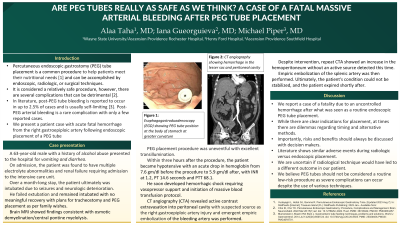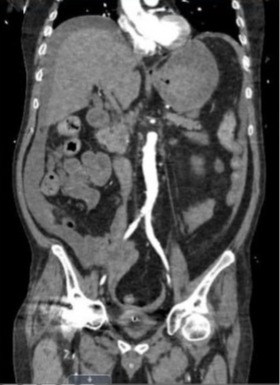Sunday Poster Session
Category: General Endoscopy
P0584 - Are PEG Tubes Really as Safe as We Think? A Case of a Fatal Massive Arterial Bleeding After PEG Tube Placement
Sunday, October 22, 2023
3:30 PM - 7:00 PM PT
Location: Exhibit Hall

Has Audio

Alaa Taha, MD
Wayne State University/Ascension Providence Rochester Hospital
Rochester, MI
Presenting Author(s)
Alaa Taha, MD1, Iana Gueorguieva, MD2, Michael Piper, MD2
1Wayne State University/Ascension Providence Rochester Hospital, Rochester, MI; 2Michigan State University/Ascension Providence - Providence Park Hospital, Southfield, MI
Introduction: Percutaneous endoscopic gastrostomy (PEG) tube placement is a common procedure to help patients meet their nutritional needs and can be accomplished by endoscopic, radiologic, or surgical techniques. It is considered a relatively safe procedure, however, there are several complications that can be detrimental. In literature, post-PEG tube bleeding is reported to occur in up to 2.5% of cases and is usually self-limiting. Post-PEG arterial bleeding is a rare complication with only a few reported cases. We present a patient case with acute fatal hemorrhage from the right gastroepiploic artery following endoscopic placement of a PEG tube.
Case Description/Methods: A 63-year-old male with a history of alcohol abuse presented to the hospital for vomiting and diarrhea. On admission, the patient was found to have multiple electrolyte abnormalities and renal failure requiring admission to the intensive care unit. Over a month-long stay, the patient ultimately was intubated due to seizures and neurologic deterioration and was subsequently evaluated for PEG tube placement. The procedure was uneventful with excellent transillumination. Three hours after the procedure, the patient became hypotensive with an acute drop in hemoglobin requiring vasopressors and initiation of massive blood transfusion. CT angiography (CTA) revealed active contrast extravasation into peritoneal cavity with suspected source as the right gastroepiploic artery injury. Interventional radiology performed an emergent embolization of the bleeding artery. Despite intervention, repeat CTA showed an increase in the hemoperitoneum without an active source detected this time. Empiric embolization of the splenic artery was then performed. Ultimately, the patient's condition could not be stabilized, and the patient expired shortly after.
Discussion: We report a case of a fatality due to an uncontrolled hemorrhage after what was seen as a routine endoscopic PEG tube placement. While there are clear indications for placement, at times there are dilemmas regarding timing and alternative methods. Importantly, risks and benefits should always be discussed with decision makers. Literature shows similar adverse events during radiologic versus endoscopic placement. We are uncertain if radiological technique would have led to a different outcome in our patient. We believe PEG tubes should not be considered a routine low-risk procedure as severe complications can occur despite the use of various techniques.

Disclosures:
Alaa Taha, MD1, Iana Gueorguieva, MD2, Michael Piper, MD2. P0584 - Are PEG Tubes Really as Safe as We Think? A Case of a Fatal Massive Arterial Bleeding After PEG Tube Placement, ACG 2023 Annual Scientific Meeting Abstracts. Vancouver, BC, Canada: American College of Gastroenterology.
1Wayne State University/Ascension Providence Rochester Hospital, Rochester, MI; 2Michigan State University/Ascension Providence - Providence Park Hospital, Southfield, MI
Introduction: Percutaneous endoscopic gastrostomy (PEG) tube placement is a common procedure to help patients meet their nutritional needs and can be accomplished by endoscopic, radiologic, or surgical techniques. It is considered a relatively safe procedure, however, there are several complications that can be detrimental. In literature, post-PEG tube bleeding is reported to occur in up to 2.5% of cases and is usually self-limiting. Post-PEG arterial bleeding is a rare complication with only a few reported cases. We present a patient case with acute fatal hemorrhage from the right gastroepiploic artery following endoscopic placement of a PEG tube.
Case Description/Methods: A 63-year-old male with a history of alcohol abuse presented to the hospital for vomiting and diarrhea. On admission, the patient was found to have multiple electrolyte abnormalities and renal failure requiring admission to the intensive care unit. Over a month-long stay, the patient ultimately was intubated due to seizures and neurologic deterioration and was subsequently evaluated for PEG tube placement. The procedure was uneventful with excellent transillumination. Three hours after the procedure, the patient became hypotensive with an acute drop in hemoglobin requiring vasopressors and initiation of massive blood transfusion. CT angiography (CTA) revealed active contrast extravasation into peritoneal cavity with suspected source as the right gastroepiploic artery injury. Interventional radiology performed an emergent embolization of the bleeding artery. Despite intervention, repeat CTA showed an increase in the hemoperitoneum without an active source detected this time. Empiric embolization of the splenic artery was then performed. Ultimately, the patient's condition could not be stabilized, and the patient expired shortly after.
Discussion: We report a case of a fatality due to an uncontrolled hemorrhage after what was seen as a routine endoscopic PEG tube placement. While there are clear indications for placement, at times there are dilemmas regarding timing and alternative methods. Importantly, risks and benefits should always be discussed with decision makers. Literature shows similar adverse events during radiologic versus endoscopic placement. We are uncertain if radiological technique would have led to a different outcome in our patient. We believe PEG tubes should not be considered a routine low-risk procedure as severe complications can occur despite the use of various techniques.

Figure: CT angiography of the abdomen showing hemorrhage in the peritoneal cavity.
Disclosures:
Alaa Taha indicated no relevant financial relationships.
Iana Gueorguieva indicated no relevant financial relationships.
Michael Piper indicated no relevant financial relationships.
Alaa Taha, MD1, Iana Gueorguieva, MD2, Michael Piper, MD2. P0584 - Are PEG Tubes Really as Safe as We Think? A Case of a Fatal Massive Arterial Bleeding After PEG Tube Placement, ACG 2023 Annual Scientific Meeting Abstracts. Vancouver, BC, Canada: American College of Gastroenterology.
